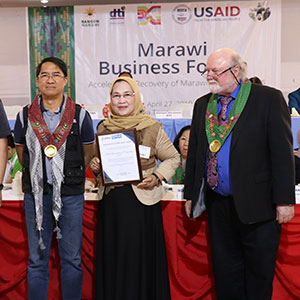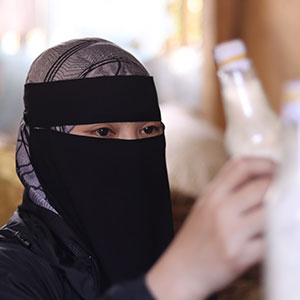Conclusions & Recommendations
The evaluation team forwards the following conclusions based on the evaluation findings discussed above:

Were MRP’s development interventions relevant to the needs of the IDPs and Host Communities and adaptive to the complex and changing external environment in Mindanao, especially in the project areas?
The development interventions that MRP implemented are relevant to the needs of the IDPs and adaptive to the complex environment of the project areas. MRP’s application of USAID’s guidance on co-creation processes, adaptive management, and local partnerships throughout the implementation of the project contributed to the relevance and adaptability of the interventions to the needs of the beneficiaries.
MRP’s business recovery and community micro-grants alongside its business and workforce development trainings addressed the economic recovery needs of the beneficiaries. Moreover, the social cohesion grants and trainings the project provided are relevant in easing out possible tensions in the operating environment where project’s beneficiaries are situated.
The project has significantly contributed to the ongoing efforts to rehabilitate Marawi by effectively collaborating with other actors in the project areas and by mainstreaming its efforts and activities. Its adaptive community-based approaches contributed to improving self-reliance among IDPs and HCMs, narrowing social gaps at the community-level, and providing enabling conditions for IDPs’ local integration.

Did MRP accomplish the project’s expected outcomes of improving self-reliance, such as increasing business and livelihood opportunities, strengthening social cohesion, and increasing participation such as in civic and economic activities among IDPs and HCMs?
MRP cushioned beneficiaries’ self-reliance from the adverse effects of external challenges particularly from the economic challenges brought about by COVID-19 pandemic. Amidst the ramifications of the pandemic, the business grants, community micro grants and trainings received by the beneficiaries allowed them to generate income by starting businesses and by engaging in gainful employment. Thus, MRP created a stimulus for the restoration of individual and community capacities to engage in economic activities. Moreover, the project’s interventions contributed to the reduction of gender and social gaps particularly those that were noted during the baseline.
MRP’s social cohesion grants and trainings fostered civic engagement and community improvement among the IDPs and HCMs. Consequently, it has contributed to the improvements in the beneficiaries’ perceptions of social relations, connectedness, and orientation towards the common good. In particular, it has improved the perceptions of the IDPs and HCMs regarding the existence of polarization in their communities and their level of public participation in civic activities.
MRP’s interventions and processes offered opportunities for IDPs’ to locally integrate as a form of durable solution to their displacement. While the durable solution preference of the IDPs appears to be a “fluid” subject matter at present, the project has contributed to the preference of those who chose to locally integrate through the business and employment opportunities it has provided to IDPs during the period of their displacement.

Did MRP establish mechanisms to promote sustainable improved economic conditions and strengthen the social cohesion between IDPs and HCMs?
MRP has established concrete sustainability mechanisms that are essential in sustaining the outcomes of the project. These mechanisms are aligned to USAID’s Local Systems Framework. Guided by the tenets of the framework, MRP strengthened the buy-in of strategic stakeholders by harnessing partnerships between and among them, which resulted to institutional complementation. It laid the foundation for the CSGs to be qualified for future government support and linked them to potential markets of their products through the sustainability policies and strategies it implemented. MRP developed building blocks for CSGs to continue to operate, serve their members, even scale-up their livelihoods after the conclusion of MRP by empowering and formalizing them into cooperatives and CSOs. MRP also established social fabric for the harmonious involvement, participation and interaction of IDPs and HCMs as they scale up their ventures by being purposive in targeting both groups in the project’s activities and interventions.
The capacity and partnership-building mechanisms that MRP carried out provided the impetus that could sustain the social and economic outcomes of the project. Moreover, MRP’s contribution through the business and livelihood grants and the workforce development training will allow the IDPs and HCMs to take advantage of the opportunities brought about by the resumption of business and livelihood activities in the localities where they reside.
The strengthening, consolidation, and social network expansion of the CSGs transformed them into advocacy/sectoral organizations serving as the strong foundation for sustaining economic and social cohesion gains. With these mechanisms, it is likely that the outcomes of the projects would be sustained after MRP ends.
The evaluation team recommends the following points for consideration by USAID, government agencies, and other development actors:
- MRP is the first development intervention of USAID that was designed through a co-creation process. Given the contribution of the process in laying down the groundwork for better adaptive management, the team recommends that future USAID development interventions especially for complex environments to consider the utilization of a co-creation process. Future interventions could benefit from the multidisciplinary perspectives that would be generated during the exercise.
- Future development interventions that are designed for complex environments such as MRP could be configured with a much longer time frame. While the MRP achieved its designed outputs and outcomes on a year-to-year basis, the realization of the durable solution of the IDPs requires more time that is beyond the life of the project.
- The team recommends an appropriate selection of the right performance indicators and clear measurements and tools to strengthen the validity of project performance data and outcomes. Moreover, the targeting for each indicator across the life of the project needs to be rationalized based on baseline assessment information, updated project implementation data, and other relevant data sources. Guided by the principles of adaptive management and learning, the targeting across the life of the project could be more pragmatic, adaptive, and relevant to the changes in the complex operational context.
- The team recommends a review of the Grant Management Manual to facilitate the quick delivery of quality interventions to project beneficiaries. In case the of MRP, issues of delay in the delivery of grants affected the project implementation. In complex operating environments, delays could a precursor to tensions among beneficiaries and other stakeholders. With this, the evaluation team reaffirms the importance of setting up the project accountability measures that foster speedy delivery of relevant and timely interventions, especially in highly complex environments.
- The LGUs should continue the partnerships with the implementing partners and other CSOs in undertaking peace and development efforts in communities covered by MRP. To build on the positive results achieved by the CSGs, the LGUs-CSOs partnership remains critical in designing and implementing joint efforts. LGUs’ commitment to provide continuing support, accompaniment, and greater space for public participation will lead to CSGs organizational development as social formations and as effective partners in implementing community projects for the collective benefit of IDPs and HCMs.
- There is a need for LGUs to follow through their commitments to foster sustainability of the economic and social cohesion outcomes of the project. It is essential that the commitments the LGUs gave during the rounds of consultation that MRP conducted would be translated to binding mechanisms. For example, the LGUs could integrate their commitments in the legislative agenda of their respective local governments. Among those are commitments related to sustaining the value chain and GBV initiatives. As such, the realization of the commitments would not be subject to changes in the leadership of concerned agencies and offices.
- Considering the fluid nature of the durable solution preference of the IDPs at the time of the evaluation, other development actors such as the academe could conduct to document the durable solution of the IDPS and how the MRP interventions have impacted their decision. Durable solutions model for the IDPs of the Marawi siege could be explored using econometric and psycho-social approaches. Results from these studies could be useful in providing context for future development interventions that USAID and other donor agencies could consider.
DISCLAIMER
This report is made possible by the support of the American people through the United States Agency for International Development (USAID). The contents of this report are the sole responsibility of Panagora Group and do not necessarily reflect the views of the United States Agency for International Development or of the United States government.